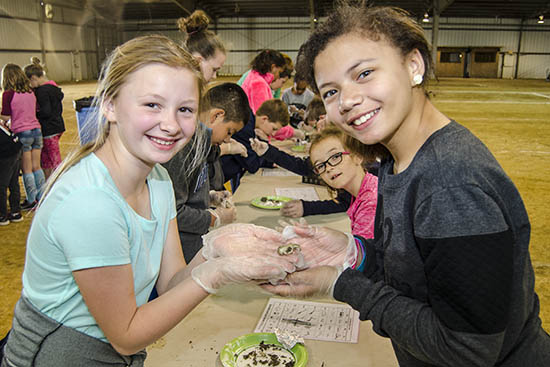4-H Goes Wild for the environment
4-H Goes Wild for the environment

Recently, more than 800 fourth-graders from eight local elementary schools descended on Madison County Fairgrounds to weave their way through exhibits at 4-H Goes Wild, an environmental field day hosted by the Madison County office of the University of Kentucky Cooperative Extension Service.
There, UK extension specialists, agents and staff, as well as students from Eastern Kentucky University and professionals from the Richmond water and sanitation departments, introduced the students to such things as insects, water pollution, a water molecule’s journey, birds and mammals, to name just a few of the 12 exhibits.
Events like this happen all over the state in any given month, because 4-H has a responsibility: to teach children to be good stewards of the planet, broaden their perspectives, stoke their curiosity and enhance their knowledge of nature.
“By piquing a child’s interest, our hope is that their interest will grow into a love and respect for that resource,” said Ashley Osborne, 4-H youth development extension specialist, referencing the varied 4-H activities that center on natural resources, one of 4-H’s core objectives.
With a range of activities such as the Natural Resource and Environmental Sciences Academy; two-day overnight environmental camps at any of four 4-H camps; competitive forestry teams; land-judging teams where 4-H’ers develop experience in soil science; and entomology, geology and gardening clubs, 4-H offers something to entice any student away from computer games for a time.
“Kids are so involved with technology, video games, that we started to see nature deficiency in some of them. Kids just don’t want to be outside anymore,” said Scott Darst, Madison County 4-H youth development extension educator. “Our job as 4-H agents is to support the teachers and the science curriculum standards, but also to gain back that interest in nature.”
The students’ enthusiasm was contagious, as they learned about the structure of trees by blowing bubbles out of seemingly solid blocks of wood and dissected regurgitated owl pellets to find unexpected little treasures.
Owls have to dispense with the indigestible part of their prey before they can eat again. The result is a dark brown, compressed, 1½-inch ball of bones, fur and feathers. Heads bent intently over the pellets as small, gloved hands used tweezers to tease out rodent or bird skulls, teeth and tiny leg bones. Phoenix Turner and Syecret Moore were thrilled to find an intact rodent skull, complete with teeth, in their pellet. Both girls said they loved science, and their excitement when they discovered each buried treasure was proof of that. Down the table from them, another girl could be heard exclaiming, “It’s fun to be a scientist.”
“We’re trying to hit all the science standards they’ve been learning in the classroom,” Darst said. “Teachers love this field day, because it’s kind of a review before they go into testing.”
It may have been a review, but it was no mere exercise in questions and answers. Using pipe cleaners, beads and giant dice, Cathy Weaver, Jessamine County 4-H youth development extension agent, led the students through the journey a water molecule takes. The children represented the molecules, and the dice directed them in no particular order around nine stations, each labeled as animal, plant, glacier, ocean, cloud, lake, soil, groundwater or river. At each station, the students collected a colored bead to add to a pipe cleaner bracelet. In the end, no two bracelets were alike, illustrating water’s random journey through the ecosystem.
UK College of Agriculture, Food and Environment entomologist Blake Newton brought his collection of fascinating (and slightly scary) insects, ranging from a benign praying mantis to a black widow spider, safely ensconced in a glass jar. He also reminded them how important pollinators are to the environment.
“If they don’t care, no one else will, and who knows what will happen,” Darst said. “Kids know, without pollination, without trees, we won’t be around much longer, because they understand the importance of cause and effect and just being good stewards.”
Osborne said the students acquire more than environmental knowledge from natural resource activities.
“In 4-H, we’re concerned with youth development, so these areas lend themselves to learning about being a responsible citizen and developing leadership skills and other life skills that will be important to them as adults,” she said.
Environment Events Extension Forestry


